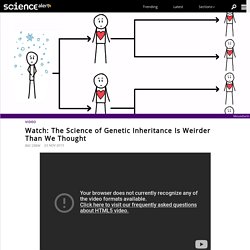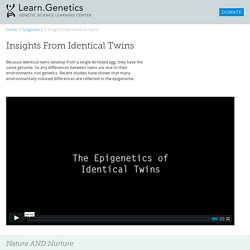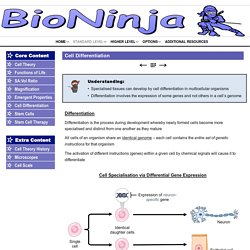

Watch: The Science of Genetic Inheritance Is Weirder Than We Thought. A basic understanding of genetic inheritance tells us that only DNA gets passed along to our offspring - traits such as memories, physical scars, and giant muscles cannot be passed on, because they're acquired through life experience, not by altering the genetic code.

But recent experimental evidence has challenged this assumption, and scientists now think that our experiences can change the way the genetic code of our children is translated by the body. Welcome to the weird and wonderful science of epigenetics, courtesy of MinuteEarth. Epigenetics is the study of how our genetics can be controlled by factors other than our DNA sequence, which means information from one generation can be transmitted to the next generation and alter certain traits without affecting their genetic material. So how does this work? In the video above, we're introduced to an experiment where male mice were taught to fear the smell of fruit by getting an electric shock every time they were exposed to it.
Kahoot! Babies who get more cuddles seem to have their genetics changed for years afterwards. Epigenetics & the Human Brain. Throughout our lives, the brain remains flexible and responsive.

In addition to receiving signals from the outside world, the brain allows us to form memories and learn from our experiences. Many brain functions are accompanied at the cellular level by changes in gene expression. Epigenetic mechanisms such as histone modification and DNA methylation stabilize gene expression, which is important for long-term storage of information. Not surprisingly, epigenetic changes are also a part of brain diseases such as mental illness and addiction.
Understanding the role of epigenetics in brain disease may open the door to being able to influence it. A segment from a June 2008 lecture given by Dr. Dr. Insights From Identical Twins. Chromosome 3 pairs in each set of twins are digitally superimposed.

One twin's epigenetic tags are dyed red and the other twin's tags are dyed green. When red and green overlap, that region shows up as yellow. The 50-year old twins have more epigenetic tags in different places than do 3-year-old twins. The insight we gain from studying twins helps us to better understand how nature and nurture work together. For well over a century, researchers have compared characteristics in twins in an effort to determine the extent to which certain traits are inherited, like eye color, and which traits are learned from the environment, such as language. Depending on the study and the particular trait of interest, data is collected and compared from identical or fraternal twins who have been raised together or apart. Twin studies have identified some traits that have a strong genetic component, including reading disabilities like dyslexia. The Epigenome at a Glance. Gene Control.
Lick Your Rats. Epigenetics. Understanding: • Nucleosomes help to regulate transcription in eukaryotes Eukaryotic DNA is wrapped around histone proteins to form compact nucleosomes These histone proteins have protruding tails that determine how tightly the DNA is packaged Modification of Histone Tails Typically the histone tails have a positive charge and hence associate tightly with the negatively charged DNA Adding an acetyl group to the tail (acetylation) neutralises the charge, making DNA less tightly coiled and increasing transcriptionAdding a methyl group to the tail (methylation) maintains the positive charge, making DNA more coiled and reducing transcription Acetylation of Nucleosomes Types of Chromatin When DNA is supercoiled and not accessible for transcription, it exists as condensed heterochromatin When the DNA is loosely packed and therefore accessible to the transcription machinery, it exists as euchromatin Nucleosome Packaging in Euchromatin and Heterochromatin Skill:

Gene Expression. Understanding: • Gene expression is regulated by proteins that bind to specific base sequences in DNA Transcriptional activity is regulated by two groups of proteins that mediate binding of RNA polymerase to the promoter Transcription factors form a complex with RNA polymerase at the promoter RNA polymerase cannot initiate transcription without these factors and hence their levels regulate gene expression.

Cell Differentiation. Understanding: • Specialised tissues can develop by cell differentiation in multicellular organisms • Differentiation involves the expression of some genes and not others in a cell’s genome Differentiation Differentiation is the process during development whereby newly formed cells become more specialised and distinct from one another as they mature All cells of an organism share an identical genome – each cell contains the entire set of genetic instructions for that organism The activation of different instructions (genes) within a given cell by chemical signals will cause it to differentiate Cell Specialisation via Differential Gene Expression Gene Packaging.

Introducing epigenetics. Gene Expression and the Order of the Operon. Gene Expression. Epigenetics. Epigenetics 101 - Dr. Bruce Lipton, PhD. Epigenetics and the influence of our genes: Courtney Griffins at TEDxOU. How the choices you make can affect your genes - Carlos Guerrero-Bosagna.